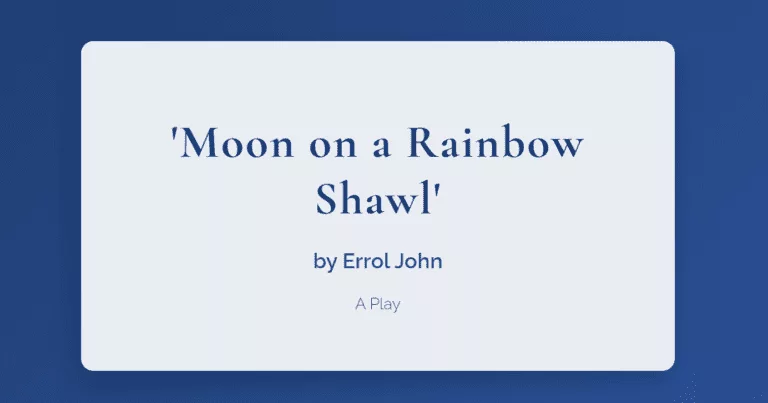Errol John, a Trinidadian playwright and actor, crafted a powerful exploration of post-colonial life in his seminal work, “Moon on a Rainbow Shawl.” First performed in 1958, this play stands as a significant contribution to Caribbean literature and drama. Set in the backyard of a shabby tenement in Port of Spain, Trinidad, John’s work delves deep into the struggles, dreams, and disillusionment of ordinary people grappling with the aftermath of colonialism.
Table of Contents
The play masterfully weaves themes of poverty, ambition, and the tension between tradition and modernity, offering a nuanced portrayal of a community at a crossroads. Through its vivid characters and raw, poetic dialogue, “Moon on a Rainbow Shawl” offers a penetrating insight into the human condition, particularly the challenges faced by those living in the shadow of colonial rule.
Brief Summary
“Moon on a Rainbow Shawl” unfolds in the cramped yard of a barrack tenement in Port of Spain, focusing on the interconnected lives of its residents. At the center of the story is Ephraim, a young man dreaming of escaping to a better life in England. His girlfriend, Rosa, hopes for marriage and a family, while their neighbor Sophia struggles to support her family, including her husband Charlie and their baby.
The play also features Esther, Sophia’s daughter, who becomes pregnant by an American soldier. As these characters navigate their hopes, disappointments, and daily struggles, the play builds to a climax that forces each to confront the harsh realities of their circumstances and the difficult choices they must make.
The Weight of Colonial Legacy
John’s play vividly portrays the lingering effects of colonialism on Trinidadian society. The characters’ aspirations and frustrations are deeply rooted in the colonial experience, reflecting the complex relationship between the colonized and their former rulers. Ephraim’s desire to leave for England, the “mother country,” symbolizes both the allure of opportunity and the internalized belief that a better life can only be found elsewhere.
The playwright skillfully illustrates this through Ephraim’s dialogue:
“I going away from here… I going to England. I going to live in a country where they don’t care what colour you is.”
This statement not only highlights the racial tensions present in post-colonial Trinidad but also the naive idealization of the colonial power, showing how deeply ingrained colonial attitudes remain.
Dreams Deferred and the Cycle of Poverty
A central theme of the play is the struggle against poverty and the way it shapes and often defers the dreams of the characters. Sophia’s constant battle to make ends meet, Charlie’s alcoholism, and Rosa’s modest hopes for a stable family life all paint a picture of lives constrained by economic hardship.
John captures this poignantly in Sophia’s lament:
“Every day the same thing. Get up in the morning, cook, wash, iron, clean… and for what? To start all over again the next day.”
This cyclical nature of poverty is a recurring motif, highlighting how difficult it is for the characters to break free from their circumstances.
Gender Roles and Female Resilience
The play offers a nuanced exploration of gender dynamics in post-colonial Trinidad. The female characters, particularly Sophia and Rosa, demonstrate remarkable resilience in the face of adversity. They are often the backbones of their families, shouldering both emotional and financial burdens.
Esther’s pregnancy and the community’s reaction to it shed light on the double standards and limited options available to women. John writes with sensitivity about Esther’s predicament:
“What you think going to happen to me now, Mamma? What you think people going to say?”
This situation forces the audience to confront the harsh realities faced by young women in this society.
The Clash of Tradition and Modernity
“Moon on a Rainbow Shawl” captures a society in transition, where traditional values and ways of life are increasingly challenged by modernization and changing social norms. This tension is embodied in the generational conflicts between characters and in their differing attitudes towards community, family, and individual aspirations.
Ephraim’s desire to leave represents a break from traditional communal ties, while Rosa’s hopes for marriage align more closely with established norms. John illustrates this clash through their dialogue, with Rosa pleading,
“You can’t just leave everything behind like that,” to which Ephraim responds, “Watch me.”
Literary Techniques in “Moon on a Rainbow Shawl”
Errol John employs several powerful literary techniques to bring his story to life:
- Realistic Dialogue: John’s use of Trinidadian Creole lends authenticity to the characters and their world. The rhythms and idioms of their speech immerse the audience in the setting.
- Symbolism: The “rainbow shawl” of the title serves as a potent symbol of beauty and hope amidst squalor and despair.
- Stage Directions: John uses detailed stage directions to create a vivid sense of place and to highlight the physical and emotional constraints of the characters’ lives.
- Character Foils: Characters like Ephraim and Charlie serve as foils, their contrasting attitudes and choices highlighting key themes of the play.
These techniques combine to create a rich, textured portrayal of life in post-colonial Trinidad, allowing the audience to connect deeply with the characters and their struggles.
Critical Reception and Impact
Upon its premiere, “Moon on a Rainbow Shawl” was hailed as a groundbreaking work of Caribbean drama. It won the Observer Play Competition in 1957 and went on to be performed at the Royal Court Theatre in London. Critics praised John’s authentic portrayal of Trinidadian life and his skillful handling of complex themes.
The play has since become a staple of Caribbean literature, studied in schools and universities across the region and beyond. Its exploration of post-colonial issues, poverty, and the human spirit continues to resonate with audiences today. The work has been revived numerous times, including notable productions at the National Theatre in London in 2012 and 2014, introducing new generations to John’s powerful storytelling.
Conclusion
“Moon on a Rainbow Shawl” stands as a testament to Errol John’s keen insight into the human condition and his ability to capture the complexities of post-colonial life. Through its vivid characters and poetic dialogue, the play offers a window into a pivotal moment in Trinidad’s history, while also touching on universal themes of hope, struggle, and the pursuit of a better life.
John’s work continues to be relevant today, offering insights into the lasting impacts of colonialism and the ongoing challenges faced by communities grappling with poverty and social change. By giving voice to the often unheard stories of ordinary people, “Moon on a Rainbow Shawl” reminds us of the power of drama to illuminate the human experience and foster empathy and understanding across cultural boundaries.
As we reflect on this remarkable play, we are left with a deeper appreciation for the resilience of the human spirit and a heightened awareness of the complex interplay between individual dreams and societal constraints. Errol John’s masterpiece invites us to look beyond the surface of daily life and consider the profound hopes, fears, and struggles that shape our common humanity.



1 Comment
Pingback: A Hundred Flowers by Gail Tsukiyama: Comprehensive Summary and Analysis - LitGram by MukeshRishit